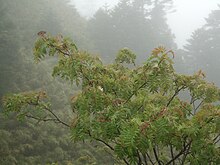Sorbus randaiensis
| Sorbus randaiensis | |
|---|---|

| |
| Scientific classification | |
| Kingdom: | Plantae |
| Clade: | Tracheophytes |
| Clade: | Angiosperms |
| Clade: | Eudicots |
| Clade: | Rosids |
| Order: | Rosales |
| Family: | Rosaceae |
| Genus: | Sorbus |
| Species: | S. randaiensis
|
| Binomial name | |
| Sorbus randaiensis | |
| Synonyms | |
|
List
| |
Sorbus randaiensis[1] is a species of deciduous tree in the family Rosaceae. It is endemic to the mountain areas of central Taiwan, with altitude 1,800m to 3,200m, mostly spotted in the forest of Xueshan, Hehuan Mountain, Mount Xiluan, and Nenggao Mountain.[2] It is a tree 3–8 m tall with white flowers and reddish fruit.[3]
Naming[edit]
It was first described as Pyrus aucuparia var. randaiensis by Bunzō Hayata in 1911, [4] then placed in Sorbus by Gen'ichi Koidzumi in 1913.[5]
Its species epithet randaiensis implies that the first type specimen was collected at Mount Xiluan.[2][a]
Description[edit]
Deciduous trees with obvious lenticel on the branches.
Leaf[edit]
Alternate, odd number pinnate leaves, with leaflets 15–21. Leaflets without petiole, shaped from long oval to lanceolate, 3–4 cm in length, 8–12 cm in width. The front end tapered, and the basal part skew, circled or obtuse. Margin jagged. Petiole with groove, and with short furs when young.
Flower[edit]
Terminal corymbs inflorescence. Pedicels are short, about 3–4 mm in length. Petals 5, white. Hypanthium with long furs, triangle shaped. Stamens 15–20, Carpels 3–5, isolated. Styles 3–5, isolated or basal synthetic. Flower perigynous.
Fruit[edit]
Schizocarp, berry-like, globular with diameter 7 mm. The front end has the remaining traces of stigma and calyx. Turn rubine at maturation.[2][6]
Phenology[edit]
First leaf for the spring sprouts during April to May. Inflorescence is on about May to June. Around September to October, their fruits ripen with rubine color. And in the October to November, their leaves turn yellow or red before falling down.[2][7]
Uses[edit]
Medicine[edit]
Its fruit, stem, and bark can be used as medicine. Although tasting bitter, it is a cure for chronic bronchitis and cough with phlegm, and is spleen-tonifying.[citation needed]
Ornamental[edit]
It is eye-catching with their beautifully-shaped appearance from branching to flowers, especially the amazing change of leaves to red and rubine fruits in October.
Food[edit]
The fruits are with juicy texture and sweetness, tasting delicious.[2]
Notes[edit]
References[edit]
- ^ 昆明植物研究所. "台湾花楸". 《中国高等植物数据库全库》. 中国科学院微生物研究所. Archived from the original on 2016-03-05. Retrieved 2009-02-25.
- ^ a b c d e "森態資料庫介紹 | 台灣山林悠遊網". recreation.forest.gov.tw. Archived from the original on 4 August 2018. Retrieved 2017-04-03.
- ^ Lu Lingdi and Stephen A. Spongberg. "Sorbus randaiensis". Flora of China. Missouri Botanical Garden, St. Louis, MO & Harvard University Herbaria, Cambridge, MA. Retrieved 1 July 2012.
- ^ Hayata, J. Coll. Sci. Imp. Univ. Tokyo 30(1): 98. 1911.
- ^ Koidzumi, The Journal of the College of Science, Imperial University of Tokyo, Japan 34(2): 52. 1913.
- ^ "巒大花楸 Sorbus randaiensis - Plants of TAIWAN 台灣植物資訊整合查詢系統". tai2.ntu.edu.tw. Retrieved 2017-03-24.
- ^ 雪霸國家公園 (2010-09-17). "巒大花楸". 雪霸國家公園. Retrieved 2017-03-24.
- 台灣植物資訊整合查詢系統
- 雪霸國家公園全球資訊網
- "Sorbus randaiensis (Hayata) Koidz., 1913". TaiBNET. Taiwan: Biodiversity Research Centre, Academia_Sinica.
External links[edit]
 Data related to Sorbus randaiensis at Wikispecies
Data related to Sorbus randaiensis at Wikispecies
